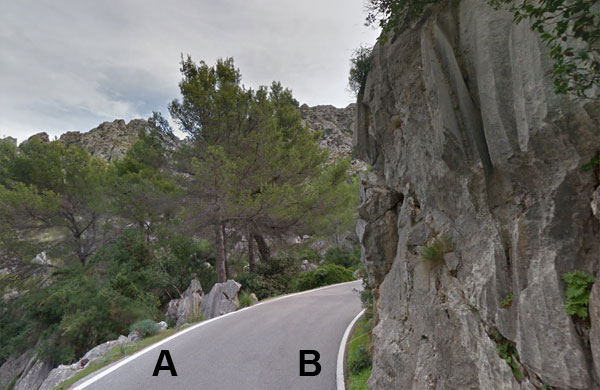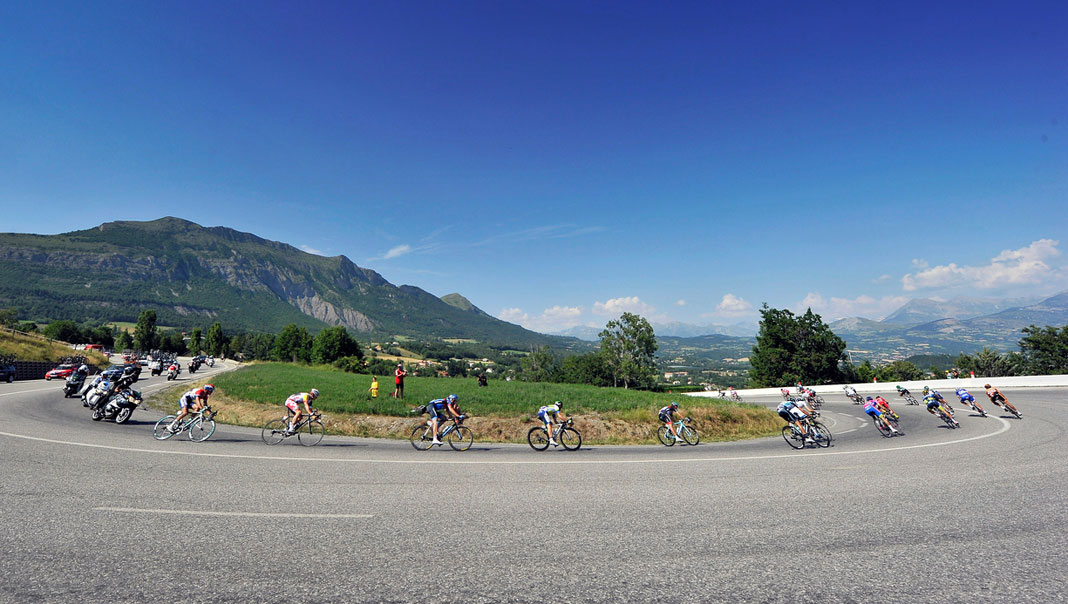You're at the top of Sa Calobra, Majorca, looking down. 26 hairpins, a drop of 2200 feet in 6 miles. You are about to launch yourself down it like a base jumper. How can you get down smoothly and fast?
Hazards/ Risk assessment
Any risky activity deserves a quick risk assessment before committing to it. Engage your brain and have a think about what you're about to do.
What's the point?
If you are in a race and trying to close a 1 minute gap, with closed roads, then you might decide that it is worth the risk of fast descending. Concentrate, relax and the flow down the mountain like a tsunami.
If you are out training, then there's no need to take risks. Descend more slowly, give yourself plenty of margin for error. Try to keep that margin at a fixed level, so don't corner crazily at one place then slowly at the next.
Don't compete for Strava downhill segments. It could be fatal.
Know the road
Knowing the road is a big advantage as you know what's coming up. Roads in the Alps tend to be well designed with predictable gradients and corner radii, which helps. If you don't know the road you'll have to either put your trust into someone who does, or slow down.
Traffic
If the road is well used, such as in the French Alps in the summer, then you'll be meeting oncoming traffic. Even if the road is quiet, you have to assume there'll be something coming around the corner.
What happens if you leave the road?
It is vital to not think about what would happen in the event of a crash. If you imagine slamming into a rock face or sliding down the road on your knees, you will easily psyche yourself out and will end up cornering like a granny.
On the other hand, consider what happens if you get the corner wrong. Will you land in a field or experience a 100m drop? Increase the margin of safety (slow down) if the risk of a mistake is death.
Road surface
If the road is potholed, flooded, strewn with gravel or fallen rocks, slow down. You will then be able to take avoiding action.
Cornering/ Lines
Descending in a straight line is easy. Time is gained and lost at the corners.
First of all, look ahead. You may be able to see where the road is going, or if there are oncoming cars. Don't rely on that look ahead, as there might be something inbetween you and your line of sight, or you may be even looking at a different road. Use it as an indicator of what might be coming next.
Trees, telegraph poles and street lights all indicate where the road should be heading, so take notice of them.
Look at the most distant point of the road. Is that point moving away (corner is opening up) from you or towards you (corner is tightening). Using that information you can decide whether to brake more or less.
Come out of your aero position and straighten the bike before braking. Braking with an angled bike on the wet could bring you down.
Apply front and back brakes. You want to brake in as short a space as possible whilst staying within your margin of error. The bike needs to stay balanced. The back brake will need less pressure as most of your weight will be transferred to the front wheel. You may need to move your ass further back over the saddle or off the saddle if the road is bumpy. Let the bike move underneath you by using a relaxed grip.
Don't drag your brakes all the way down because you feel you're going too fast. This will wear out your brake pads and rims and could cause a tire to burst from overheating. Only brake when you need to, i.e. before the next corner. Your brakes will do a great job of slowing you down.
On a hot day, you may wish to pulse your brakes to reduce rim temperature, although this won't produce the quickest stopping times. Be more aware of heavy braking on descents if you have carbon rims, as these are mor prone to overheating and delamination.
If it is wet, don't apply too much back brake as this will make the back end swap with the front and you'll end up on the ground.
It is especially important to avoid painted lines and drain covers in the wet, as these will offer less friction than the road surface.
If the conditions are wet and dry, for example patches of damp road, then look at your tire before the corner to see how wet it is. If the tire is dry and the corner is dry, then you can go faster.
Weight the outside pedal and keep it down. Unweight the saddle slightly. This will allow your bike to pivot under you, which gives more grip over lumps and bumps. You will also be able to lean the bike more with the inside pedal up, which translates to faster cornering.
Keep low over the bike as this will lower your center of gravity, allowing for a faster turn.
Consider the line you are taking through the corner. Usually you would imagine that the racing line is the fastest. However in real world conditions, you can ride faster if you can see what is ahead. You can do this by taking a wider entry into the corner so you can see around it. It isn't the line a Formula 1 driver would take, but it will allow you to go faster round the corner.

Position B is the shortest way around the corner, aka the racing line, but if you are in position A you can see further around the corner so would need to brake less.
Ensure that you are not so far to the left that you are on the camber/ gravel or that you can't get back in towards B if something is coming. Image: Google Maps, Sa Calobra, Mallorca, Spain.
Ensure that you are not so far to the left that you are on the camber/ gravel or that you can't get back in towards B if something is coming. Image: Google Maps, Sa Calobra, Mallorca, Spain.
You may need to cross onto the oncoming side of the road to see around the corner. Ensure that you cross only far enough so that you can get back to your side of the road if something is coming.
Look for gravel or moss on the road. This can often be found in the center of small roads. You should try to stay off this central area as grip will be uncertain. There may also be rocks in this area. Keep to the path that is kept clean by car tires. Don't cut the corner, stay in the tire marks as you descend.
Roads also have a camber of about 2 degrees from either side of the center line to assist with rain water run off. If the road is turning right, then you want to be on the right side of the road. The angle between you and the ground is reduced by 2 degrees, so you can corner a bit harder - like on the banking of a velodrome.
The opposite is true if you happen to find yourself on the left side of the road when cornering right. First of all there may be oncoming traffic, but second of all you will now have an adverse camber of 2 degrees. Your bike will slip away from you more easily. The key to avoiding this situation is to look ahead and know the descent if possible.
If, half way through the corner you feel that you've overcooked it, the worst thing you can do is hit the brakes. This will straighten the bike and will send you to the opposite side of the road (or into the bushes). You are better off adopting the motocross maxim, which is - if in doubt, gas it'. Obviously don't pedal in the corner, but just crank the bike further over. You might find that your margin for error was much bigger than you thought. Or you might low side your bike, which is not as bad as leaving the road or hitting an oncoming vehicle.
Generally when starting out, riders brake too much. Half way round the corner they think 'I could have taken that faster'. Next time, brake a little less so you approach the corner faster. Keep doing this until you are comfortable with the exit speed.
As you come out of the corner, straighten the bike then apply some power. You might be OK to freewheel or you might need to sprint. Just make sure the bike is upright before you put the inside pedal down as striking a pedal on descents usually results in a crash.
If descending in a group, everyone normally rides single file, and the leader shows responsibility for the group by descending smoothly and not recklessly. Call out if there are oncoming vehicles, but wind noise normally renders hearing as useless.
Conclusion
Like many things in life, getting faster at descending requires practice. Learn the road. Learn your bike and its tires. Stay low and relaxed and don't allow your imagination to get overactive. Thinking of crashing will turn you into a bundle of nerves. Obviously having read this, you'll think about crashing, but I thought it was best to let you know.
Enjoy descending after all that hard work on the climb has been done. Don't take any unnecessary risks - remember to ride for tomorrow.
Links
The joy of descending. Fabian Cancellara, Port del Comte in Stage 7 of the 2009 Tour de France. He's particularly good as he's a relatively heavy cyclist.
